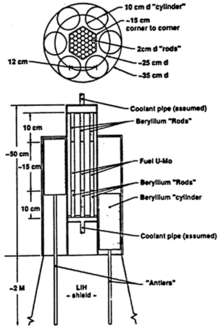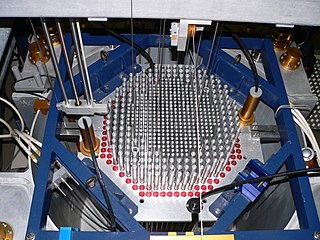
A nuclear reactor is a device used to initiate and control a fission nuclear chain reaction or nuclear fusion reactions. Nuclear reactors are used at nuclear power plants for electricity generation and in nuclear marine propulsion. Heat from nuclear fission is passed to a working fluid, which in turn runs through steam turbines. These either drive a ship's propellers or turn electrical generators' shafts. Nuclear generated steam in principle can be used for industrial process heat or for district heating. Some reactors are used to produce isotopes for medical and industrial use, or for production of weapons-grade plutonium. As of 2022, the International Atomic Energy Agency reports there are 422 nuclear power reactors and 223 nuclear research reactors in operation around the world.
Enriched uranium is a type of uranium in which the percent composition of uranium-235 has been increased through the process of isotope separation. Naturally occurring uranium is composed of three major isotopes: uranium-238, uranium-235, and uranium-234. 235U is the only nuclide existing in nature that is fissile with thermal neutrons.
A nuclear electric rocket is a type of spacecraft propulsion system where thermal energy from a nuclear reactor is converted to electrical energy, which is used to drive an ion thruster or other electrical spacecraft propulsion technology. The nuclear electric rocket terminology is slightly inconsistent, as technically the "rocket" part of the propulsion system is non-nuclear and could also be driven by solar panels. This is in contrast with a nuclear thermal rocket, which directly uses reactor heat to add energy to a working fluid, which is then expelled out of a rocket nozzle.
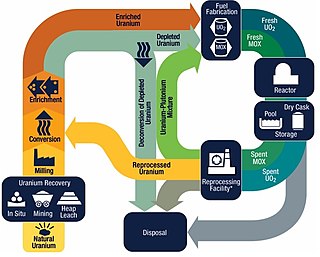
The nuclear fuel cycle, also called nuclear fuel chain, is the progression of nuclear fuel through a series of differing stages. It consists of steps in the front end, which are the preparation of the fuel, steps in the service period in which the fuel is used during reactor operation, and steps in the back end, which are necessary to safely manage, contain, and either reprocess or dispose of spent nuclear fuel. If spent fuel is not reprocessed, the fuel cycle is referred to as an open fuel cycle ; if the spent fuel is reprocessed, it is referred to as a closed fuel cycle.
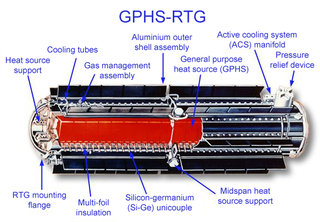
A radioisotope thermoelectric generator, sometimes referred to as a radioisotope power system (RPS), is a type of nuclear battery that uses an array of thermocouples to convert the heat released by the decay of a suitable radioactive material into electricity by the Seebeck effect. This type of generator has no moving parts. Because they don't need solar energy, RTGs are ideal for remote and harsh environments for extended periods of time, and because they have no moving parts, there is no risk of parts wearing out or malfunctioning.
Kosmos is a designation given to many satellites operated by the Soviet Union and subsequently Russia. Kosmos 1, the first spacecraft to be given a Kosmos designation, was launched on 16 March 1962.

Kosmos 954 was a reconnaissance satellite launched by the Soviet Union in 1977. A malfunction prevented safe separation of its onboard nuclear reactor; when the satellite reentered the Earth's atmosphere the following year, it scattered radioactive debris over northern Canada, some of the debris landing in the Great Slave Lake next to Fort Resolution, NWT.
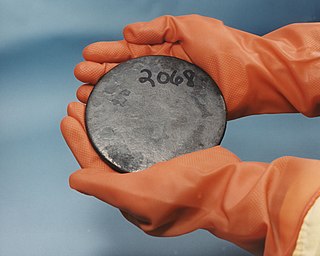
Uranium-235 is an isotope of uranium making up about 0.72% of natural uranium. Unlike the predominant isotope uranium-238, it is fissile, i.e., it can sustain a nuclear chain reaction. It is the only fissile isotope that exists in nature as a primordial nuclide.
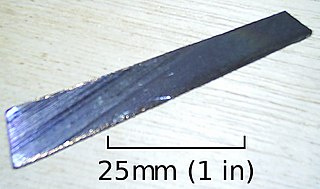
Uranium-238 is the most common isotope of uranium found in nature, with a relative abundance of 99%. Unlike uranium-235, it is non-fissile, which means it cannot sustain a chain reaction in a thermal-neutron reactor. However, it is fissionable by fast neutrons, and is fertile, meaning it can be transmuted to fissile plutonium-239. 238U cannot support a chain reaction because inelastic scattering reduces neutron energy below the range where fast fission of one or more next-generation nuclei is probable. Doppler broadening of 238U's neutron absorption resonances, increasing absorption as fuel temperature increases, is also an essential negative feedback mechanism for reactor control.

Upravlyaemy Sputnik Aktivnyy, or US-A, also known in the west as Radar Ocean Reconnaissance Satellite or RORSAT, was a series of 33 Soviet reconnaissance satellites. Launched between 1967 and 1988 to monitor NATO and merchant vessels using radar, the satellites were powered by nuclear reactors.

Nuclear fuel is material used in nuclear power stations to produce heat to power turbines. Heat is created when nuclear fuel undergoes nuclear fission.

SNAP-10A was a US experimental nuclear powered satellite launched into space in 1965 as part of the SNAPSHOT program. The test marked both the world's first operation of a nuclear reactor in orbit, and the first operation of an ion thruster system in orbit. It is the only fission reactor power system launched into space by the United States. The reactor stopped working after just 43 days due to a non-nuclear electrical component failure. The Systems Nuclear Auxiliary Power Program reactor was specifically developed for satellite use in the 1950s and early 1960s under the supervision of the U.S. Atomic Energy Commission.

Fertile material is a material that, although not fissile itself, can be converted into a fissile material by neutron absorption.
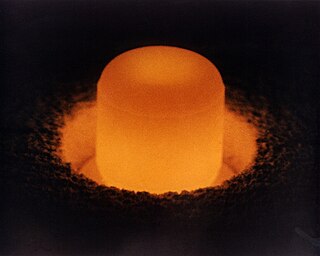
Plutonium-238 is a radioactive isotope of plutonium that has a half-life of 87.7 years.
The Systems Nuclear Auxiliary POWER (SNAP) program was a program of experimental radioisotope thermoelectric generators (RTGs) and space nuclear reactors flown during the 1960s by NASA.

The Romashka reactor was a Soviet experimental nuclear reactor. It began operation in 1964, and was developed by the Kurchatov Institute of Atomic Energy. The reactor used direct thermoelectric conversion to create electricity, rather than heating water to drive a turbine. It is thus similar to a radioisotope thermoelectric generator, but higher power.
Kosmos 1818 was a nuclear powered Soviet surveillance satellite in the RORSAT program, which monitored NATO vessels using radar. Kosmos 1818 was the first satellite to use the TOPAZ-1 fission reactor. In July 2008, the satellite was damaged, and leaked a trail of sodium coolant.
Kosmos 1867 is a nuclear powered radar ocean reconnaissance satellite (RORSAT) that was launched by the Soviet Union on July 10, 1987. It was put into an orbit of about 800 km (500 mi). Its mission was to monitor the oceans for naval and merchant vessels, and had a mission life of about eleven months.
Kosmos 1402 was a Soviet spy satellite that malfunctioned, resulting in the uncontrolled re-entry of its nuclear reactor and its radioactive uranium fuel. Kosmos 1402 was launched on August 30, 1982, and re-entered the atmosphere on 23 January 1983. The fission reactor entered a few days later; on 7 February 1983.

Nuclear power in space is the use of nuclear power in outer space, typically either small fission systems or radioactive decay for electricity or heat. Another use is for scientific observation, as in a Mössbauer spectrometer. The most common type is a radioisotope thermoelectric generator, which has been used on many space probes and on crewed lunar missions. Small fission reactors for Earth observation satellites, such as the TOPAZ nuclear reactor, have also been flown. A radioisotope heater unit is powered by radioactive decay and can keep components from becoming too cold to function, potentially over a span of decades.
